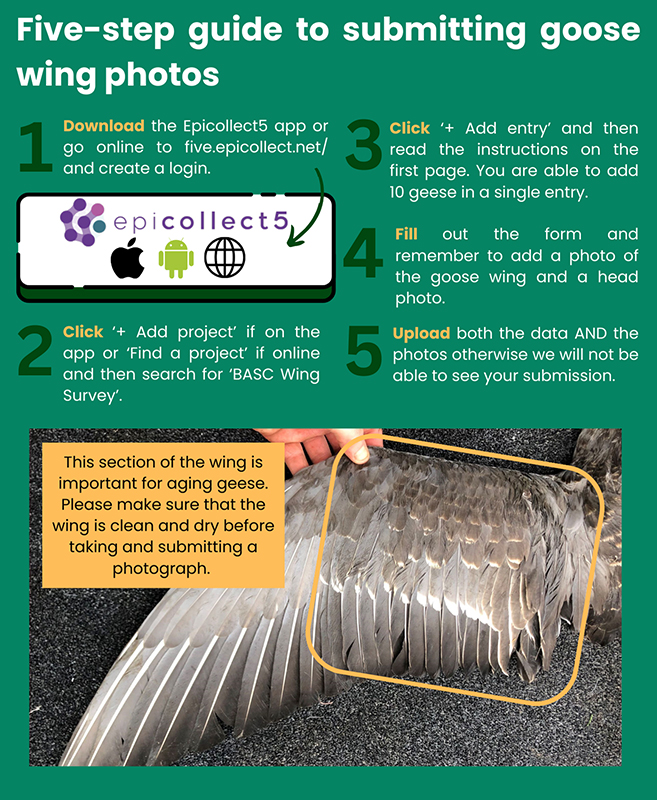Nature recovery advisor (desk-based)
The nature recovery advisor is a new role and will be at the forefront of BASC’s growth and work for sustainable shooting.
Get information on the legal shooting season for mammals and birds in the UK.
Learn about our current conservation projects and how you can get involved.
Comprehensive information and advice from our specialist firearms team.
Everything you need to know about shotgun, rifle and airgun ammunition.
Find our up-to-date information, advice and links to government resources.
Everything you need to know on firearms law and licensing.
All the latest news and advice on general licences and how they affect you.


Home » Test
The wing survey has been running since 1965, but our best data is from the 1980s onwards. It tells us the ages and sexes of the quarry species shot and submitted each year.
Since 1986, more than 46,000 wings have bee submitted to the survey, providing a hugely valuable resource to assess population changes over a long period of time.
You can get involved in the wing survey throughout the wildfowling season (see information below).
By contributing to the survey, you will be adding towards a valuable dataset. Together, we can ensure that we have the evidence of responsible harvest of wildfowl and are acting sustainably by monitoring the species we shoot. This information ultimately contributes to safeguarding the future of wildfowling.
Find out more below about how to submit your wing data.


The wing survey is a monitoring project which collects data about shot ducks, geese and waders from wings sent to us by shooters. Wings provide invaluable information about the age and sex ratios of waterbird harvests.
The data can be used to provide information such as the timing of migratory bird arrival at different locations in the UK, breeding success. Over time, such information will help us understand whether we take sustainable portions of the population.
Many huntable species demonstrate population declines in the UK and in Europe. There is a lack of accurate population and hunting data for many of these species, therefore any information we can collect is vital to their long-term conservation.
Data from wing surveys across the world is used to monitor shot populations. For example, USA, Denmark and France have successful, long-term wing surveys which feed data into international trends such as the Wetlands International’s Waterbird Population Estimates.
Working with the Waterfowlers’ Network, we will share results from our wing survey to contribute to the bigger picture of what is happening to waterfowl populations across the North West European Flyway (NWEF).
These wide-ranging species require a combined effort from all countries that share the flyway to collect information about their numbers, distribution and harvest.
With an increasing amount of regulation surrounding wildfowling, mainly due to the uncertainty surrounding our migratory bird populations, more data on population composition and hunting is vital.
By taking part in the survey, you be are contributing to the data we have been collecting since 1986. With long-term trends, we can fill the gaps in our understanding of waterbird populations to make more informed decisions about how we can harvest them sustainably.
Thank you to everyone who has supported the survey over the years. Please promote the scheme to your fellow wildfowlers and duck and goose shooters and to continue sending us wings as we move forward.
The nature recovery advisor is a new role and will be at the forefront of BASC’s growth and work for sustainable shooting.

The Deer Stalking Certificate (DSC1) is designed for shooters who have recently taken up stalking and are seeking further knowledge and guidance.
There is no excerpt because this is a protected post.
Sign up to our weekly newsletter and get all the latest updates straight to your inbox.
© 2024 British Association for Shooting and Conservation. Registered Office: Marford Mill, Rossett, Wrexham, LL12 0HL – Registered Society No: 28488R. BASC is a trading name of the British Association for Shooting and Conservation Limited which is authorised and regulated by the Financial Conduct Authority (FCA) under firm reference number 311937.
If you have any questions or complaints about your BASC membership insurance cover, please email us. More information about resolving complaints can be found on the FCA website or on the EU ODR platform.
This website uses cookies so that we can provide you with the best user experience possible. Cookie information is stored in your browser and performs functions such as recognising you when you return to our website and helping our team to understand which sections of the website you find most interesting and useful.
Strictly Necessary Cookie should be enabled at all times so that we can save your preferences for cookie settings.
If you disable this cookie, we will not be able to save your preferences. This means that every time you visit this website you will need to enable or disable cookies again.
This website uses Google Analytics to collect anonymous information such as the number of visitors to the site, and the most popular pages.
Keeping this cookie enabled helps us to improve our website.
Please enable Strictly Necessary Cookies first so that we can save your preferences!
More information about our Cookie Policy